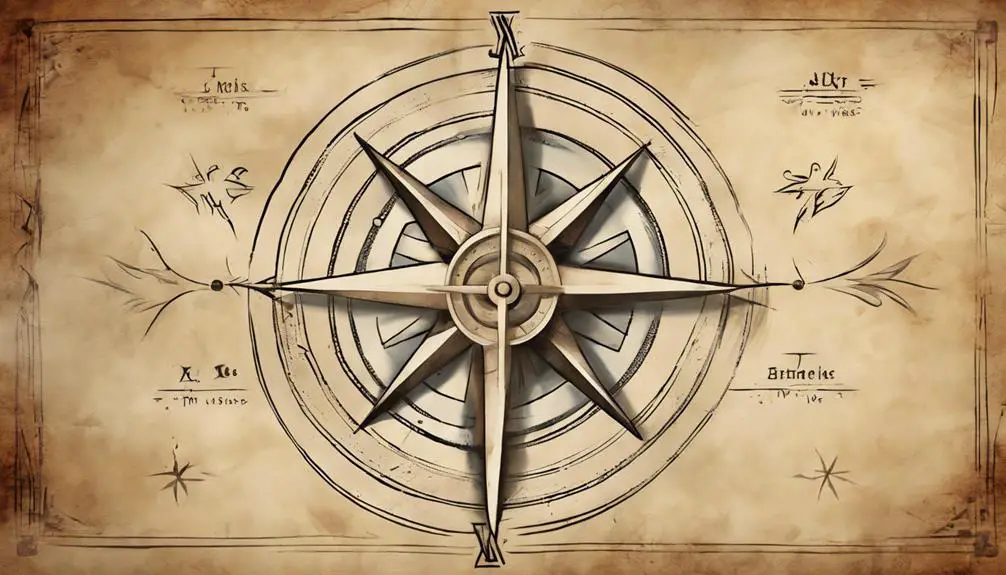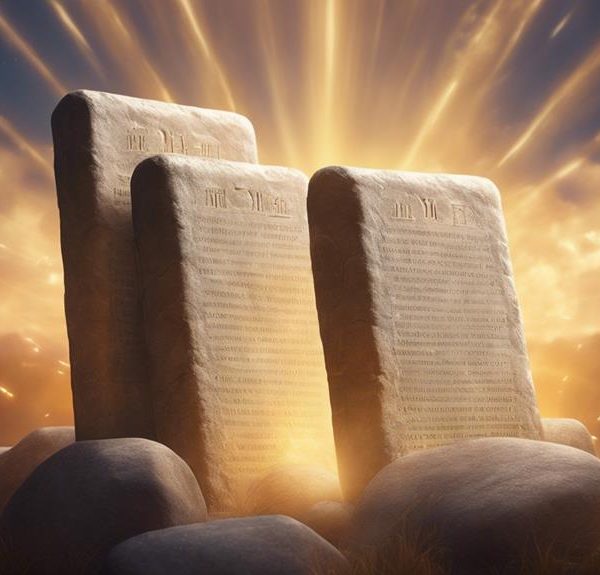Uncover the profound symbolism of the four biblical winds, each weaving a unique tapestry of divine guidance and mystery.

The 4 Winds in the Bible
Just as Odysseus navigated the unpredictable seas with the help of Aeolus' winds, you'll find the four winds of the Bible carry their own intriguing symbolism and significance, guiding the faithful through spiritual tempests.
Exploring the east, west, north, and south winds isn't merely about understanding ancient meteorology; it's about uncovering the deeper theological insights these elements hold within the scriptures.
From the destructive power of the east wind to the refreshing southern breezes, each direction offers unique perspectives on divine intervention and human experience.
You're on the cusp of uncovering how these biblical winds have shaped faith, prophecy, and interpretation through ages.
Key Takeaways
- The East Wind symbolizes divine judgment and is a call to reflection and repentance.
- The West Wind represents redemption, healing, and signals God's provision for prosperity.
- The North Wind is associated with purification, challenging believers to grow through trials.
- The South Wind signifies comfort, spiritual renewal, and marks a season of harvest and abundance.
The East Wind: Symbolism and Significance

In biblical texts, the East Wind emerges as a powerful symbol of divine intervention, often heralding significant change or judgment upon the people. This wind, unlike any other, serves as a destruction metaphor throughout scripture, illustrating God's sovereignty and the fragility of human endeavors in the face of divine will. You'll find that the East Wind doesn't just represent God's capacity for destruction but also signifies a cleansing or purifying force, preparing the way for new growth or a return to faithfulness.
The agricultural effects of the East Wind are particularly noteworthy. It's often depicted as drying up waters and withering crops, a direct impact on the livelihood and sustenance of the people. This imagery isn't merely about loss; it's a call to reflection and repentance, urging communities to recognize their dependence on God's grace and mercy. The East Wind, therefore, isn't just a harbinger of doom but a reminder of the need for spiritual renewal and the importance of adhering to divine commandments.
The West Wind: Interpretations and Impact
The West Wind, often overlooked, plays a crucial role in biblical narratives, symbolizing redemption and the divine promise of healing for those who've strayed. This interpretation is deeply rooted in the cultural connotations and agricultural effects associated with the West Wind in ancient times. Analyzing its impact offers a multifaceted understanding of its significance. Here's how you can appreciate its role:
- Cultural Connotations: The West Wind was seen as a harbinger of change, often associated with the transition from hardship to prosperity. Its appearance in scripture can signify a pivotal moment where divine intervention redirects the course of events, offering a fresh start.
- Agricultural Effects: In an agrarian society, the West Wind's significance extended to its impact on crops. It's often seen as bringing rain necessary for growth, symbolizing God's provision and sustenance for His people.
- Symbol of Redemption: The West Wind's role in facilitating change and growth underscores its symbolic representation of redemption. It's a reminder that no one is beyond the reach of divine mercy.
- Divine Promise: Its presence in biblical stories serves as a tangible sign of God's promise to heal and restore, emphasizing the ongoing relationship between the Creator and creation.
The North Wind: Biblical References and Meanings

Moving from the West Wind's role in signaling redemption, let's now explore how the North Wind holds distinct biblical references and meanings, often embodying purification and divine challenge. In Scripture, the North Wind is frequently associated with divine judgment and the delivery of prophetic messages. It's not merely a meteorological phenomenon but a symbol loaded with theological significance.
You'll find that in the Bible, the North Wind serves as God's instrument, often sweeping in with force to purify or to challenge His people. For instance, in Proverbs 25:23, the North Wind is said to bring forth rain, symbolizing the inevitable nature of divine judgment and the cleansing that follows. Similarly, in the Song of Solomon 4:16, the North Wind is invoked to 'awake' and scatter the garden's perfumes, symbolizing the spreading of God's word or the divine challenge to spread faith.
This wind's harshness mirrors the trials and tribulations that believers may face, but also underscores the necessity of such divine interventions for growth and purification. The North Wind, therefore, isn't just a harbinger of cold but a reminder of the refining processes that shape faith and character according to divine will.
The South Wind: Themes and Theological Insights
Shifting our focus to the South Wind, we uncover a distinct biblical narrative that weaves together themes of comfort, warmth, and spiritual renewal. This gentle breeze from the south isn't merely a meteorological phenomenon; it's a symbol laden with profound theological insights that speak directly to the human condition. Here's what you'll find when delving into the scripture's portrayal of the South Wind:
- Gentle Growth: Unlike the harsher winds that might symbolize trials, the South Wind represents a time of nurturing and gentle growth in faith and character. It's a reminder that not all spiritual development comes through adversity; some come in the warmth of God's love and grace.
- Seasonal Shifts: The Bible often uses seasonal imagery to depict spiritual truths. The South Wind signals a shift towards a season of harvest and abundance, both physically and spiritually, reminding believers of God's provision and timing.
- Comfort and Warmth: In times of cold and desolation, the South Wind speaks of God's comforting presence, bringing warmth to the soul and reviving hope.
- Spiritual Renewal: Just as the South Wind can change the climate, it symbolizes the refreshing and renewing work of the Holy Spirit in the believer's life, encouraging a deeper walk with God.
Through these themes, the South Wind offers a rich tapestry of insights that encourage reflection on God's gentle but powerful work in our lives.
Frequently Asked Questions
How Do the Four Winds Relate to Modern Christian Practices and Beliefs?
In modern Christian practices, you'll find the essence of wind rituals and spiritual navigation deeply intertwined with faith. These elements aren't just metaphors; they're active parts of worship and personal guidance. They symbolize change, guidance, and the Holy Spirit's movement.
You're engaging in a tradition that transcends time, where the winds not only represent divine direction but also how you're called to move and grow in your spiritual journey.
Are There Any Significant Differences in How the Four Winds Are Depicted or Understood in Other Religious Texts Outside of the Bible?
Yes, there are significant differences in how wind deities and the concept of the four winds are depicted in other religious texts outside the Bible. These variations often reflect cultural symbolism and beliefs unique to each society.
For instance, in some traditions, wind deities are seen as creators or destroyers, embodying both life-giving and destructive powers. This contrasts with the more directional or prophetic roles they play in biblical contexts.
In Biblical Prophecy, Do the Four Winds Symbolize Specific Events or Epochs in Human History?
In examining biblical prophecy, you'll find that the four winds don't just stir the air; they symbolize pivotal epochs in human history. With a 100% chance of angelic representation, these winds carry deep geographic symbolism, marking territories of divine action.
Analyzing texts, it's scholarly agreed that these winds, under God's command, depict transformative periods, each with unique implications on humanity's spiritual journey, a faith-based interpretation that enriches our understanding of divine intervention.
How Have Interpretations of the Four Winds Changed Throughout Different Historical Periods or Within Various Christian Denominations?
You'll find that cultural interpretations and denominational divergence play key roles in how the concept of the four winds has evolved.
Analyzing these shifts, it's apparent that historical periods and various Christian denominations have nuanced their understanding, reflecting broader theological and cultural trends.
This scholarly, faith-based exploration reveals a fascinating mosaic of beliefs, showing how interpretations aren't static but dynamically interact with changing societal values and religious insights.
Can the Concept of the Four Winds Be Linked to Environmental Stewardship or Ecological Themes Within a Biblical Context?
You're exploring how wind symbolism ties into ecological ethics from a biblical perspective. This concept suggests that understanding the significance of winds in scripture can deepen your appreciation for environmental stewardship.
Conclusion
So, you've traversed the tempestuous terrain of biblical breezes, from the perilous East Wind, with its penchant for plagues, to the sultry South Wind, whispering of seduction and sin.
You've dissected the divine drafts, North to South, and what've you found? That perhaps, just perhaps, the Almighty had a bit more on His mind than meteorology.
In this whirlwind tour of theological thermals, it's clear: He wasn't just forecasting weather, but weaving wisdom into the winds. Let's hope we're astute enough to catch these celestial currents.



Sign up